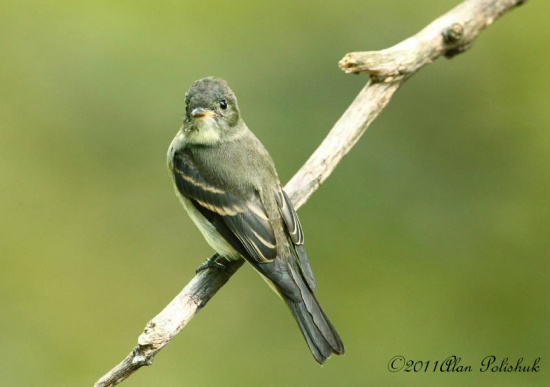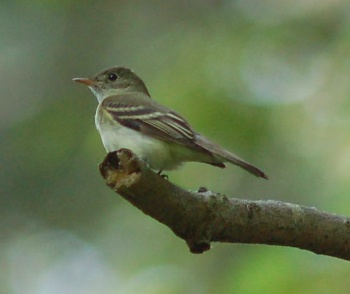Nutcracker (talk | contribs) (better pic) |
Nutcracker (talk | contribs) m (link) |
||
| Line 15: | Line 15: | ||
==Distribution== | ==Distribution== | ||
| − | [[Image:Empidonax virescens by Terry O'Nolley.jpg|thumb|350px|right|Adult in spring<br>Photo by {{user|Terry+O'Nolley|Terry O'Nolley}}<br>Patuxent River State Park, [[Maryland]]; May 2007]] | + | [[Image:Empidonax virescens by Terry O'Nolley.jpg|thumb|350px|right|Adult in spring<br>Photo by {{user|Terry+O'Nolley|Terry O'Nolley}}<br>[[Patuxent National Wildlife Research Refuge|Patuxent River State Park]], [[Maryland]]; May 2007]] |
Breeds in the eastern [[United States]], and just into the extreme south of [[Canada]] in southwestern [[Ontario]]. In the US, west to southeastern [[South Dakota]], central [[Kansas]] and southern [[Texas]], east to southern [[New England]], and south to [[Gulf Coast]], and central [[Florida]]. Most abundand in [[Virginia]] and [[West Virginia]]<sup>[[#References|[2]]]</sup>. Migrates mainly through eastern [[Mexico]]; scarce on the western Caribbean islands. Winters in Central America and northern South America, from [[Nicaragua]] southwest to [[Ecuador]] and east to [[Venezuela]]. | Breeds in the eastern [[United States]], and just into the extreme south of [[Canada]] in southwestern [[Ontario]]. In the US, west to southeastern [[South Dakota]], central [[Kansas]] and southern [[Texas]], east to southern [[New England]], and south to [[Gulf Coast]], and central [[Florida]]. Most abundand in [[Virginia]] and [[West Virginia]]<sup>[[#References|[2]]]</sup>. Migrates mainly through eastern [[Mexico]]; scarce on the western Caribbean islands. Winters in Central America and northern South America, from [[Nicaragua]] southwest to [[Ecuador]] and east to [[Venezuela]]. | ||
| Line 21: | Line 21: | ||
A very rare vagrant west of the breeding range, with records from [[New Mexico]] and [[British Columbia]]. | A very rare vagrant west of the breeding range, with records from [[New Mexico]] and [[British Columbia]]. | ||
| + | |||
==Taxonomy== | ==Taxonomy== | ||
This is a monotypic species. | This is a monotypic species. | ||
Revision as of 13:58, 26 November 2014
- Empidonax virescens
Identification
Length 13-14.5 cm, weight 12.2-14 g
- One of the larger Empidonax flycatchers
- Olive-green upperparts with two white wingbars (buffy in juveniles) and white tertial fringes
- Underparts white with a hint of yellow
- Long primary projection
- Narrow but obvious pale eye ring
- Bill slender, broad-based, pinkish-yellow below, dark above
- Molts in late summer on breeding grounds; fall migrants in fresh plumage
Similar Species
Yellow-bellied and Least Flycatcher are smaller; Yellow-bellied also darker yellow-brown beneath and smaller billed, and Least grayer above and whiter below and has a smaller bill. Alder and Willow Flycatchers are browner above and whiter below, and with less obvious eye rings. Western Empidonax flycatchers have darker lower mandibles, and either whiter underparts (Gray and Dusky Flycatchers), darker breasts (Hammond's Flycatcher), or oval eye rings (Pacific Slope and Cordilleran Flycatchers) as well as only rarely occurring in the same areas on passage and the winter grounds. Pewees are obviously larger, browner above, whiter below and lack obvious eye rings[1].
Distribution
Breeds in the eastern United States, and just into the extreme south of Canada in southwestern Ontario. In the US, west to southeastern South Dakota, central Kansas and southern Texas, east to southern New England, and south to Gulf Coast, and central Florida. Most abundand in Virginia and West Virginia[2]. Migrates mainly through eastern Mexico; scarce on the western Caribbean islands. Winters in Central America and northern South America, from Nicaragua southwest to Ecuador and east to Venezuela.
Listed as Endangered in Canada, with only around 25-75 pairs annually, all close to Lake Erie[3].
A very rare vagrant west of the breeding range, with records from New Mexico and British Columbia.
Taxonomy
This is a monotypic species.
Habitat
Breeds in mature moist deciduous or mixed forests of preferably over 40 hectares size with shrubby understory, often close to running water. Less common in, but will use, conifer plantations. In smaller, fragmented forests suffers high levels of nest parasitism by Brown-headed Cowbirds.
Behaviour
The diet includes insects which they catch by hawking and gleaning, and some berries and seeds.
Vocalisation
The song is a loud peet-sa. The call is a soft peet.
References
- www.mbr-pwrc.usgs.gov
- cornell.edu
- Ontario birds: Acadian flycatcher





